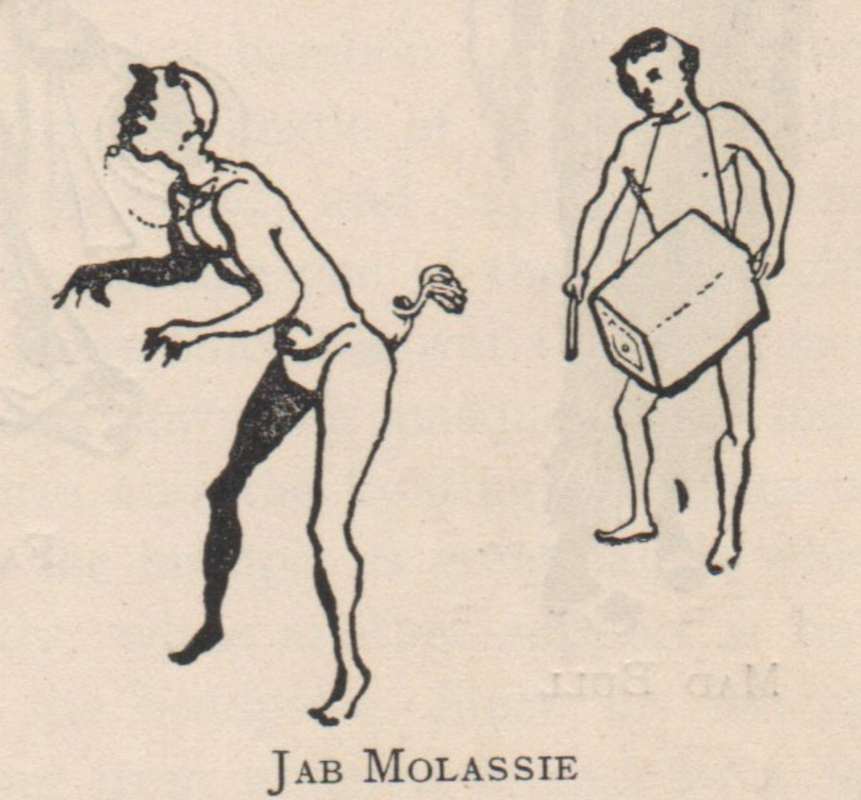Carnival
Jab Molassie in Trinidad
Attracting thousands of visitors every year, Carnival in Trinidad is one of the most prolific displays of human joy on earth. It is a time of celebration and freedom, rejoicing in the fact that you have lived to see another year. One form of masquerade that is not as widely known is the tradition of Jab Molassie, which is one of the several varieties of devil masquerade portrayed during Trinidad Carnival. Usually covered head to toe in black oil, paint or molasses and adorned with horns, Jab Molassie existed in Trinidad as well as other Caribbean islands (notably, Grenada) far longer than the feathered costumes that Trinidad’s Carnival has become known for. With origins deeply rooted in the remnants of culture brought over by enslaved Africans, Jab Molassie is an ode to the resilience of African descendants during enslavement and colonization in the Caribbean.
Jab Molassie can be traced to the traditions of sugar cane farming, specifically the burning of the cane fields to make harvesting easier. Canboulay (derived from the French phrase: “Cannes Brûlees”) refers to the processions that occurred during the burning of cane fields. Before Emancipation, whenever a fire broke out in the cane fields, slaves were gathered and led to the location to control the fire. Conch shells were used to signal the other estates in the area and slave drivers cracked their whips marching the enslaved to the burning crop or Cannes Brûlee.
After emancipation, the formerly enslaved people continued Canboulay emulating the aforementioned actions to quell cane field fires. This time, they used a variety of costumes in their processions to mock their former masters (as seen in masquerade characters like the Dame Lorraine, a woman depicted with exaggerated curves wearing French aristocratic dress), as well as to display elements of Afro-Trinidadian Folklore such as the Moko Jumbie (a reenactment of the Dogon stilt masqueraders of Mali). While each costume character is beloved and beautiful in its own regard, the most frightening of the portrayals is the Jab Molassie.

Demonic in appearance, people usually attribute Jab Molassie as an interpretation of a devil. However, it is widely believed that the Jab Molassie is an Afro-Caribbean depiction of the Orisha deity, Esu. Originally from Nigeria, Esu is known as the trickster in the Yoruba pantheon. During slavery, practicing African religious activities such as “obeah”, or witchcraft, were seen as demonic. Jab Molassie was a way to portray the devils that slave owners believed the Africans were. Ironically, Jab Molassie is also said to critique the former slave masters as the devils they were for committing the horrific act of chattel slavery.
After the Canboulay Riots in 1884, which was a rebellion for the freedom to celebrate carnival, the Canboulay processions were relegated to the wee hours of the night. This was the beginning of modern day J’ouvert (derived from the French phrase: “Jour Ouvert”, which translates to opening of the day). As time passed, different types of devil masquerade developed including Jab Jab (a spiritual and intricately costumed devil) and Blue Devils. Now we can see Jab Molassie still covered in oil or paint and sometimes carrying live snakes, dead pigs and dragging chains to continue the tradition of a frightening devil. We can also see how the messy nature of the Jab Molassie masquerade inspired the commercial form of J’ouvert that most carnival visitors are familiar with. In this form of playing mas everyone is invited to join in the true spirit of Carnival.
In essence, Jab Molassie is an expression of freedom. It embraces West African history and addresses the horrors of slavery. The art form of Jab Molassie was formed out of the oppression of Afro Caribbean people and it reiterates the message of resistance today.
Works Cited
Max Farrar (2019) The Caribbean Carnival, Caribbean Quarterly, 65:4, 553-574, DOI: 10.1080/00086495.2019.1682357
Emily Zobel Marshall (2019) “I Stole the Torturer’s Tongue”, Caribbean Quarterly, 65:4, 621-645, DOI: 10.1080/00086495.2019.1682359
Sirek, Danielle. 2018. “Until I Die, I will Sing My Calypso Song”: Calypso, Soca, and Music Education Across a Generational Divide in Grenada, West Indies. Action, Criticism, and Theory for Music Education 17 (3): 12–29. doi:10.22176/act17.3.12
Tola Dabiri (2019) How Did the Devil Cross the Deep Blue Sea?, Caribbean Quarterly, 65:4, 603-620, DOI:
10.1080/00086495.2019.1685765

